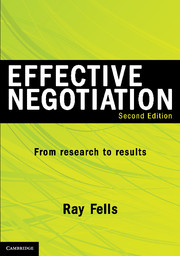Book contents
- Frontmatter
- Contents
- Preface
- Acknowledgements
- 1 Why isn't negotiation straightforward?
- 2 The DNA of negotiation
- 3 The knight's move
- 4 Phases and phrases
- 5 A negotiation script and other ways to manage a negotiation
- 6 Digging deep to deal with differences
- 7 Light bulb moments: exploring for options
- 8 A final balancing act: the end-game exchange
- 9 Building bridges
- 10 Cross-cultural negotiations: much the same but different
- 11 Becoming an effective negotiator
- References
- Index
11 - Becoming an effective negotiator
- Frontmatter
- Contents
- Preface
- Acknowledgements
- 1 Why isn't negotiation straightforward?
- 2 The DNA of negotiation
- 3 The knight's move
- 4 Phases and phrases
- 5 A negotiation script and other ways to manage a negotiation
- 6 Digging deep to deal with differences
- 7 Light bulb moments: exploring for options
- 8 A final balancing act: the end-game exchange
- 9 Building bridges
- 10 Cross-cultural negotiations: much the same but different
- 11 Becoming an effective negotiator
- References
- Index
Summary
Box 11.1 Key elements of negotiation
Negotiation is a mix of competitiveness and cooperation.
Negotiation is about an issue as well as about the process.
Negotiation involves choice.
Negotiation is two-sided.
Negotiation is messy.
Box 11.2 An up-front summary of advice to negotiators
Be pragmatic – negotiation is messy.
Negotiation, like politics, is the art of the possible.
Remember at all times: negotiation is two-sided.
Others can make choices too.
Be inquisitive and acquisitive.
Always ask ‘Why?’ and ‘What if?’ and ‘Can we get a better outcome than this?’
Create a new script
Be confident managing the process but be prepared to improvise.
Treat others with respect.
This is the only golden rule.
In Chapter 1 we started this examination of negotiation by making five key points: that negotiation is a mix of competitiveness and cooperation, it is about a process as well as an issue, it involves choice, it is two-sided and it is messy. These core features have been evident throughout the book and, no doubt, in your own negotiations. Some preliminary advice was offered to help you to be pragmatic, to remember the two-sidedness of negotiation, to be inquisitive and acquisitive, to create a new script and, importantly, to treat others with respect. This final chapter will draw on the material presented in the earlier chapters to provide a more comprehensive view of what it means to be an effective negotiator. It will first consider the characteristics of what constitutes a good negotiation because it is the negotiation, particularly the implementation of the negotiated agreement, that matters.
- Type
- Chapter
- Information
- Effective NegotiationFrom Research to Results, pp. 233 - 240Publisher: Cambridge University PressPrint publication year: 2012

